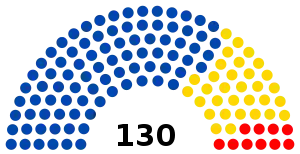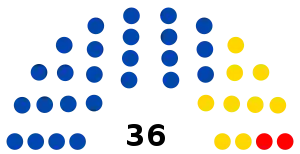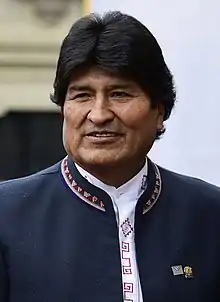| |||||||||||||||||||||||||
| Turnout | 87.90% | ||||||||||||||||||||||||
|---|---|---|---|---|---|---|---|---|---|---|---|---|---|---|---|---|---|---|---|---|---|---|---|---|---|
|
| |||||||||||||||||||||||||
Presidential election | |||||||||||||||||||||||||
| |||||||||||||||||||||||||
 Results by department | |||||||||||||||||||||||||
| |||||||||||||||||||||||||
General elections were held in Bolivia on 12 October 2014, the second to take place under the country's 2009 constitution, and the first supervised by the Plurinational Electoral Organ, a newly created fourth branch of government. Incumbent President Evo Morales was re-elected for a third term.
Bolivian voters elected the President and Vice President of the Republic, 130 members of the Chamber of Deputies, and 36 members of the Senate, as well as the five first directly elected deputies to the Andean Parliament.
Background
In April 2013, the Supreme Court ruled that the first term of President Evo Morales did not count towards constitutional term limits as the constitution of Bolivia had since been replaced. On 20 May, Vice President Alvaro Garcia Linera signed a bill into law in the presence of MPs, members of the armed forces and Movement for Socialism representatives. He said: "President Evo Morales is constitutionally permitted to run for re-election in 2015." This was despite Morales not having made an announcement to run. Unnamed opposition leaders said they would appeal the ruling in trying to overturn it.[1]
Election schedule
The Supreme Electoral Tribunal (TSE) said in November 2013 that it is considering holding the election in October 2014, so any second round of presidential voting could take place in December, the traditional month for presidential elections.[2] The TSE formally convened the election for 12 October 2014. Registration for new voters opened on 10 May and ran through to 9 June.[3] Formal inter-party alliances needed to be finalized by July 14 to appear on the ballot. Campaign advertising was permitted only from 12 September to 8 October.[3] Bolivia observes limits on electoral activity in the days immediately preceding an election, and special restrictions on election day.[3]
Electoral system
The president was elected using a modified form of the two-round system; a candidate would be elected in the first round if they received over 50% of the vote, or if they received over 40% of the vote and were at least 10 percentage points ahead of their nearest rival. If neither threshold were, a run-off was planned for 7 December.[3][4]
Each of the nine departments had four Senators,[5] whilst the 130 seats in the Chamber of Deputies were elected from 63 single-member districts (uninominal) and 60 from multi-member (plurinominal) districts. The number of seats in each department was apportioned according to their population, as determined by the 2012 national census.[6]
Senators and deputies in the plurinominal seats were elected based on parties' vote share in the presidential contest. Deputies from the uninominal seats were elected by a separate vote.[5] In cases of an exact tie in the uninominal seats, a run-off would have been held on 9 November.[3] Indigenous or Campesino seats were chosen by the usos y costumbres of minority groups.
Each candidate was required to have an elected alternate from the same party. All candidate lists had to alternate between men and women; in the uninominal districts, the alternates were required to be from the opposite gender.[5]
| Department | Total deputies |
Uninominal deputies |
Plurinominal deputies |
Indigenous or Campesino deputies |
Senators |
|---|---|---|---|---|---|
| La Paz | 29 | 14 | 14 | 1 | 4 |
| Santa Cruz | 28 | 14 | 13 | 1 | 4 |
| Cochabamba | 19 | 9 | 9 | 1 | 4 |
| Potosí | 13 | 7 | 6 | 0 | 4 |
| Chuquisaca | 10 | 5 | 5 | 0 | 4 |
| Oruro | 9 | 4 | 4 | 1 | 4 |
| Tarija | 9 | 4 | 4 | 1 | 4 |
| Beni | 8 | 4 | 3 | 1 | 4 |
| Pando | 5 | 2 | 2 | 1 | 4 |
| Total | 130 | 63 | 60 | 7 | 36 |
| Source: Ley de distribución de escaños entre departamentos | |||||
Parties and candidates
Five parties (including one party alliance) contested the presidential elections.
Movement for Socialism
Sitting President Evo Morales Ayma and Vice President Álvaro García Linera were seeking re-election, following victories in 2005 and 2009. Their candidacy was endorsed by the Movement for Socialism – Political Instrument for the Sovereignty of the Peoples (MAS-IPSP) at its 18th anniversary gathering in March 2013 and its Seventh General Congress in October 2013.
Without Fear Movement
The center-left Without Fear Movement (MSM) nominated party founder, and 2000–2010 Mayor of La Paz Juan del Granado as its candidate for president on November 11, 2013.[7] Both the party and its candidate were allies with the first Evo Morales administration, and the MSM ran on a joint slate with the MAS-IPSP in the 2009 election, but the alliance ruptured shortly afterwards.
Democrat Unity Coalition
The largest opposition parties—the Democrats (MDS), National Unity Front (UN; convener of the Broad Front), and Without Fear Movement—held a variety of talks discussing possible alliances from late 2013 through June 2014. On June 17, the Democrats and National Unity announced the formation of the Democrat Unity Coalition (Spanish: Concertación Unidad Demócrata; CUD). CUD's candidates for president and vice president were UN leader Samuel Doria Medina and Ernesto Suárez, respectively.[8] Suárez is the former governor of Beni and leader of the Beni First party, which collaborated in the formation of the MDS.
Democrat Social Movement
Rubén Costas, governor of Santa Cruz department, founded the Democrat Social Movement to contest the 2014 elections.[9] The party fused Costas' Truth and Social Democracy (VERDES) party, Renewing Freedom and Democracy (Libertad y Democracia Renovadora; LIDER), and Popular Consensus, although the merger was not legally recognized.[10] Costas was chosen as the party's presidential nominee at its National Congress on December 15, 2013.[11][12] However, the party entered into an alliance with the National Unity Front, and supported the latter group's candidate Samuel Doria Medina.
Broad Front
National Unity Front, the party led by Samuel Doria Medina, named its alliance for 2014 the Broad Front (Spanish: Frente Amplio). Doria Medina, a presidential candidate in 2005 and 2009, was the presumed candidate for the Front for months.[13][14] On December 23, 2013, the Broad Front and the Revolutionary Nationalist Movement (MNR) signed an agreement to present a common candidate, to be selected by an internal primary election. Leaders of both parties said they were seeking a coalition with the Democrats and the Without Fear Movement.[15]
On April 19–20, 2014, the Broad Front held a poll of its members in the nine departmental capitals of Bolivia. Doria Medina received a majority of 69% among the 2,652 people polled, making him the party's official presidential candidate. Other candidates participating were: indigenous leader Rafael Quispe of CONAMAQ, political scientist Jimena Costa and MNR faction leader Erick Morón. While the party did not officially announce the vote totals received by other contenders, the newspaper La Razón reported that Costa received 14%, Quispe 10%, and Morón 6%.[16]
Christian Democratic Party
Former president Jorge Fernando "Tuto" Quiroga Ramírez was the candidate of the Christian Democratic Party, which had recently been part of the PODEMOS opposition front. His running mate was Tomasa Yarhui, a lawyer and former Minister of Campesino Affairs.
Green Party
The Green Party, led by Margot Soria Saravia and affiliated with the Global Greens, sealed an alliance with the National Council of Ayllus and Markas of Qullasuyu (CONAMAQ) to campaign jointly for the 2014 elections.[17] CONAMAQ leader Rafael Quispe had considered heading the ticket, but he publicly stated that his organization's goal is not to win the presidency but to gain independent representation in the Plurinational Assembly: "God willing I am wrong, but I don't think that we will arrive to power yet in 2014, as we have discussed [among ourselves]. We could put in assembly members and those assembly members will have to work for a Plurinational State and in [the] 2019 [elections] we would arrive in power to transform the Colonial State into a Plurinational State."[18] The Confederation of Indigenous Peoples of Bolivia separately committed to contest the elections in alliance with CONAMAQ, and independently of the MAS and other major parties (Without Fear, National Unity, or Social Democrat).[19]
On June 26, the Green Party finalized its candidates: Fernando Vargas, leader of the indigenous communities of the Isiboro Sécure National Park and Indigenous Territory for president, and Margot Soria Saravia for vice president.[20]
Other alliances among parties
Official alliances between parties allow for joint candidates and ballot lines. These must be finalized by the July 14 deadline for candidacies. Aside from the Democrat Unity Coalition, other political forces engaged in alliance talks.
The largest opposition parties—the Democrats (MDS), National Unity Front (UN; convener of the Broad Front), and Without Fear Movement—held a variety of talks discussing possible alliances from late 2013 through June 2014. In the end, the Democrats and National Unity were able to reach an agreement, while the Without Fear Movement remained separate.
Seven smaller parties—Revolutionary Nationalist Movement, Nationalist Democratic Action, New Republican Force, Civic Solidarity Union, Front for Victory, Andean Amazonic Power, and Colla Power—reported progress towards a common alliance on June 18. The bloc would be called United for Bolivia (Unidos por Bolivia), and a congressional deputy involved in alliance talks promised it would be finalized on June 25.[21] Several of these parties—Nationalist Democratic Action, New Republican Force, the faction of the Revolutionary Nationalist Movement led by Johnny Torres, as well the Revolutionary Left Movement (MIR), Bolivian Socialist Falange (FSB), and New Citizen Power (NPC)—threw their support behind the Christian Democrats and candidate Jorge Tuto Quiroga.[22]
Eligible parties
As of November 2013, the Supreme Electoral Tribunal deemed twelve political parties eligible to participate in the election at a national level:
- Nationalist Democratic Action (ADN)
- Revolutionary Left Front (FRI)
- Revolutionary Nationalist Movement (MNR),
- Christian Democratic Party (Bolivia) (PDC)
- Movement for Socialism (MAS)
- Civic Solidarity Union (UCS)
- Without Fear Movement (MSM),
- National Unity Front (UN)
- Plan Progress for Bolivia (PPB)
- Front for Victory (FPV)
- Green Party of Bolivia (PVB)
- Popular Consensus (CP)[23]
Eleven further applications were still being considered as of November 9, 2013.[23]
Policy issues
Energy policy
The incumbent MAS-IPSP has proposed building a nuclear power plant, while the opposition Christian Democrats and Without Fear Movement oppose the development of nuclear energy. The Christian Democrats describe the move as dangerous and likely to generate international opposition, while the Without Fear Movement describes a power plant as a megaproject "that will leave nothing for the people."[24]
Opinion polls
An unnamed poll in April 2013 suggested in an hypothetical race Morales would get 41% and Samuel Doria Medina would get 17% of the vote.[1] A poll conducted by Página Siete in February 2014 showed Morales would get 45.7% of the vote, Medina would get 13.4%, Rubén Costas would get 9%, and Juan del Granado would get 4%.[25] According to poll conducted by Ipsos in August 2014 Evo Morales would get 59% and Samuel Doria Medina would get 17% of the vote.
Results
  | |||||||||
|---|---|---|---|---|---|---|---|---|---|
| Party | Presidential candidate | Votes | % | Seats | |||||
| Chamber | +/– | Senate | +/– | ||||||
| Movement for Socialism | Evo Morales | 3,173,304 | 61.36 | 88 | 0 | 25 | –1 | ||
| Democrat Unity | Samuel Doria Medina | 1,253,288 | 24.23 | 32 | – | 9 | – | ||
| Christian Democratic Party | Jorge Quiroga | 467,311 | 9.04 | 10 | – | 2 | – | ||
| Movement Without Fear | Juan del Granado | 140,285 | 2.71 | 0 | –4 | 0 | – | ||
| Green Party of Bolivia | Fernando Vargas | 137,240 | 2.65 | 0 | – | 0 | – | ||
| Total | 5,171,428 | 100.00 | 130 | 0 | 36 | 0 | |||
| Valid votes | 5,171,428 | 94.24 | |||||||
| Invalid/blank votes | 316,248 | 5.76 | |||||||
| Total votes | 5,487,676 | 100.00 | |||||||
| Registered voters/turnout | 6,243,138 | 87.90 | |||||||
| Source: TSE | |||||||||
References
- 1 2 "Bolivia law lets Morales run for third term".
- ↑ "Tribunal Electoral de Bolivia analiza cronograma de elecciones 2014". Prensa Latina. 2013-11-06. Retrieved 2013-11-12.
- 1 2 3 4 5 Cartagena, Jenny (2014-05-02). "El calendario de elecciones 2014 está en marcha". Los Tiempos. Archived from the original on 2014-05-05. Retrieved 2014-05-20.
- ↑ Articles 52 and 53. Ley del Régimen Electoral, 30 June 2010.
- 1 2 3 Ley del Régimen Electoral, 30 June 2010.
- ↑ Ley de distribución de escaños entre departamentos, 7 October 2013.
- ↑ "A 11 meses de comicios exsocio de Evo es el primer candidato a la presidencia". Opinión. Cochabamba, Bolivia. 2013-11-12. Retrieved 2013-11-12.
- ↑ Cuiza, Paulo (2014-06-17). "Demócratas y UN sellan alianza electoral y lanzan el binomio Samuel Doria Medina - Ernesto Suárez Sattori - La Razón". La Razón. Retrieved 2014-06-19.
- ↑ Candori, Iván (2013-03-29). "Costas da forma a un nuevo partido". La Razón. Archived from the original on 2019-11-13. Retrieved 2013-11-24.
- ↑ "TSE inscribe al Movimiento Demócratas". Los Tiempos. Cochabamba, Bolivia. 2013-08-28. Archived from the original on 2013-12-03. Retrieved 2013-11-24.
- ↑ "El MDS elige a Rubén Costas como candidato presidencial para 2014". La Razón (15 December 2013 ed.). Retrieved 2014-04-29.
- ↑ "Demócratas arrancan previas y Costas no descarta ser candidato". Opinión. Cochabamba, Bolivia. 2013-11-05. Retrieved 2013-11-24.
- ↑ Mealla, Luis (2013-09-15). "Opositores elegirán candidatos un año antes de los comicios de 2014". La Razón. La Paz, Bolivia. Retrieved 2013-11-24.
- ↑ Aguilar Agramont, Ricardo (2013-11-24). "El MSM ya tiene 20 aliados, 13 los Demócratas y 11 el Frente Amplio". La Razón. La Paz, Bolivia. Archived from the original on 2013-12-02. Retrieved 2013-11-24.
- ↑ Frente Amplio y MNR buscan un candidato Archived 27 December 2013 at the Wayback Machine
- ↑ Ariñez, Rubén (2014-04-29). "El candidato del Frente Amplio es Doria Medina". La Razón. Retrieved 2014-04-29.
- ↑ "El Partido Verde y Conamaq firman acuerdo político rumbo a las elecciones". Opinión. Cochabamba, Bolivia. 2013-11-28. Retrieved 2013-11-29.
- ↑ "ojalá que me equivoque, no creo que este 2014 lleguemos al poder todavía, eso hemos hablado. Podemos meter asambleístas y esos asambleístas tendrían que trabajar por un Estado Plurinacional y el 2019 llegaríamos al poder para transformar un Estado Colonial en un Estado Plurinacional” "Quispe: No creo que lleguemos al poder este 2014". Erbol Digital. 2013-11-04. Archived from the original on 2013-12-03. Retrieved 2013-11-29.
- ↑ "CIDOB y CONAMAQ pactan ir juntas a las elecciones". Erbol Digital. 2013-11-27. Archived from the original on 2013-11-29. Retrieved 2013-11-29.
- ↑ asam.E2012d (2014-06-26). "El Partido Verde lanza su binomio, Vargas y Soria". Erbol Digital. Archived from the original on 2014-10-19. Retrieved 2014-08-04.
{{cite news}}: CS1 maint: numeric names: authors list (link) - ↑ "7 agrupaciones políticas buscan alianza electoral". Los Tiempos. 2014-06-19. Archived from the original on 2014-07-14. Retrieved 2014-06-19.
- ↑ "Tuto suma respaldo de partidos y organizaciones". El Día. 2014-08-05. Retrieved 2014-08-05.
- 1 2 "TSE: 12 frentes pueden participar de elecciones 2014". Erbol Digital. 2013-11-09. Archived from the original on 2013-12-03. Retrieved 2013-11-29.
- ↑ "MSM y PDC advierten peligro en desarrollo de energía nuclear". Erbol Digital. 2014-08-05. Retrieved 2014-08-05.
- ↑ ¿Por qué Evo es primero en las encuestas? Archived 1 March 2014 at the Wayback Machine


